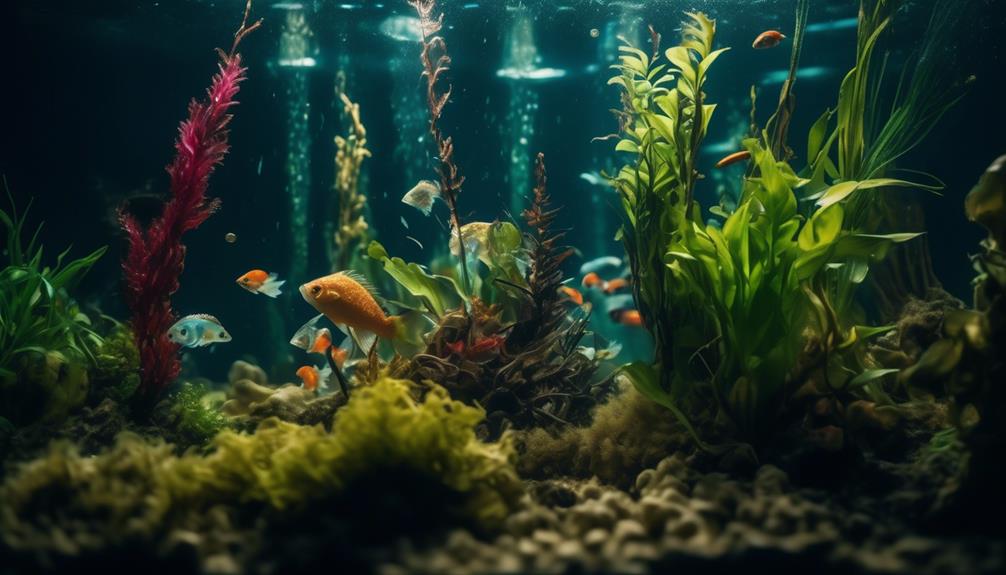
In the realm of aquatic creatures, few can match the destructive and aggressive nature of Oscars. With their impressive length, reaching up to 18 inches, these cichlids command attention wherever they reside.
Originating from the Amazon River basin in South America, Oscars present unique challenges for those who choose to keep them as pets. This article will explore their ferocious tendencies, shedding light on their origins, habitat requirements, and maintenance needs.
By delving into the world of Oscars, readers will gain a deeper understanding of these captivating creatures and the careful care they demand.
Key Takeaways
- Oscars are large and aggressive cichlids, reaching up to 18 inches in length.
- They require a minimum tank size of 55 gallons and sturdy decorations to accommodate their territorial behavior.
- Oscars have a varied carnivorous diet, including fish, worms, shellfish, shrimp, and occasional beef heart.
- Careful handling and monitoring of their health are necessary to ensure their overall well-being.
Physical Characteristics of Oscars

Oscars are large and visually striking cichlids with distinct physical characteristics. Growing up to 18 inches long, they possess thick, rectangular-shaped bodies that contribute to their commanding presence.
These freshwater fish species are known for their vibrant colors, which can range from shades of orange, red, and black. Their fins are elongated and flowing, adding to their overall dramatic appearance.
Additionally, Oscars have a unique feature called a nuchal hump, a pronounced bump on their forehead that develops as they mature. This hump is more prominent in males and is believed to play a role in courtship and territorial displays.
Natural Habitat of Oscars

The natural habitat of Oscars can be found in the Amazon River basin in South America. These freshwater fish are known for their beauty and individual personalities.
Oscars have thick, rectangular-shaped bodies and can grow up to 18 inches long. As adults, they’re highly territorial and aggressive. Due to their destructive nature, Oscars require large aquariums, with a minimum size of 55 gallons for a single fish. They’ve a tendency to uproot and destroy plants, so tank decorations should be sturdy.
Oscars are carnivores, with a diet consisting of fish, worms, shellfish, shrimp, and occasional beef heart. They can also accept most meat-based pellet foods.
Tank Requirements for Oscars
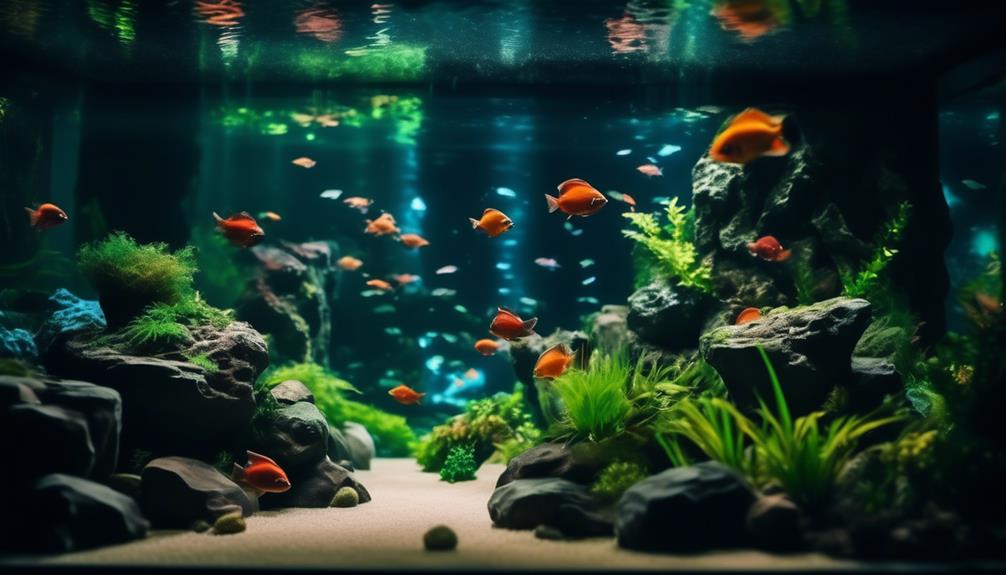
Coming from the natural habitat of the Amazon River basin, Oscars require specific tank requirements to thrive in captivity. These requirements ensure that the Oscars have enough space to move, express their territorial behavior, and maintain their overall health. Here are the key tank requirements for Oscars:
| Requirement | Description | Importance |
|---|---|---|
| Tank Size | Oscars require a minimum tank size of 55 gallons for a single fish. | Crucial |
| Tank Decorations | Sturdy decorations that can withstand Oscars’ movements are necessary. | Important |
| Filtration System | Strong filtration systems are needed to handle the significant waste produced by Oscars. | Vital |
These tank requirements for Oscars should be carefully considered when setting up their aquarium to create a suitable and thriving environment for these ferocious fish.
Aggressive Behavior of OscarsWith their territorial and aggressive nature, Oscars are known for their ferocious behavior. These fish can be extremely aggressive towards other tank mates, especially when they feel their territory is being invaded. They’ll chase and attack other fish, often causing serious injuries or even death.
Oscars also have a tendency to bite and nip at the fins of other fish, leaving them vulnerable to infections and diseases.
In addition to their aggressive behavior towards other fish, Oscars can also display aggression towards their owners. They may become territorial over their feeding area and show aggression when someone approaches the tank.
It’s important for owners to be cautious and handle Oscars with care to avoid any potential harm.
Feeding Patterns of Oscars

After discussing the aggressive behavior of Oscars, it’s important to understand their feeding patterns.
Oscars are carnivores and have a varied diet. Their primary source of food consists of fish, worms, shellfish, shrimp, and occasional beef heart. In addition to these live food options, they can also accept most meat-based pellet foods.
It’s important to provide a balanced diet for Oscars to ensure their overall health and well-being. Feeding should be done in small quantities multiple times a day to mimic their feeding habits in the wild. This helps prevent overeating and reduces the risk of digestive issues.
Compatibility With Other Fish Species
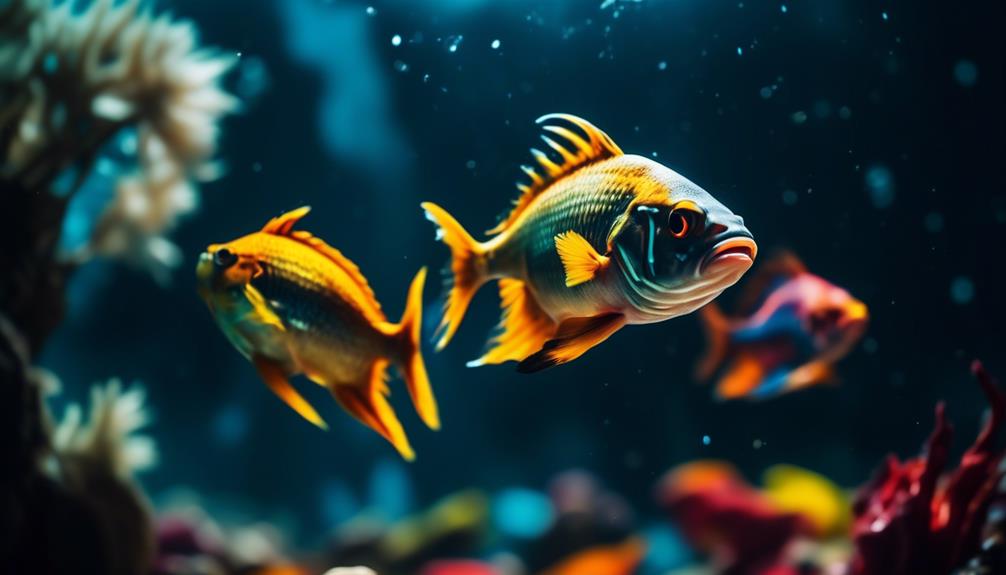
Oscars’ compatibility with other fish species depends on their aggressive and territorial nature. Due to their behavior, it’s important to carefully consider tank mates when keeping Oscars.
Here are three key factors to consider when choosing compatible fish species:
- Size: Oscars can grow up to 18 inches long and require a large aquarium. It’s important to select fish species that are similar in size to avoid any potential harm caused by size disparities.
- Aggression: Oscars are known for their aggressive behavior. It’s best to house them with large, moderately aggressive South American cichlids or catfish. Avoid keeping them with smaller, more docile fish that may become targets of aggression.
- Habitat: Oscars are destructive and have a tendency to uproot and destroy plants. When choosing tank mates, consider species that can tolerate the Oscars’ rooting behavior and can withstand substrate disturbance.
Dealing With Oscars’ Destructive Natureo address the destructive nature of Oscars, owners must implement effective strategies for managing their behavior.
Oscars have a tendency to uproot and destroy plants in their aquariums, making it essential to choose sturdy decorations and live plants that can withstand their rooting behavior.
Regular monitoring of plant health is necessary, as damaged roots should be promptly addressed to prevent plant death.
Additionally, providing a large enough tank with plenty of hiding spots and territories can help minimize aggression and territorial disputes among Oscars.
It’s also crucial to house Oscars with compatible tank mates, such as large, moderately aggressive South American cichlids or catfish, to reduce the risk of aggressive interactions.
Choosing Suitable Tank Decorations
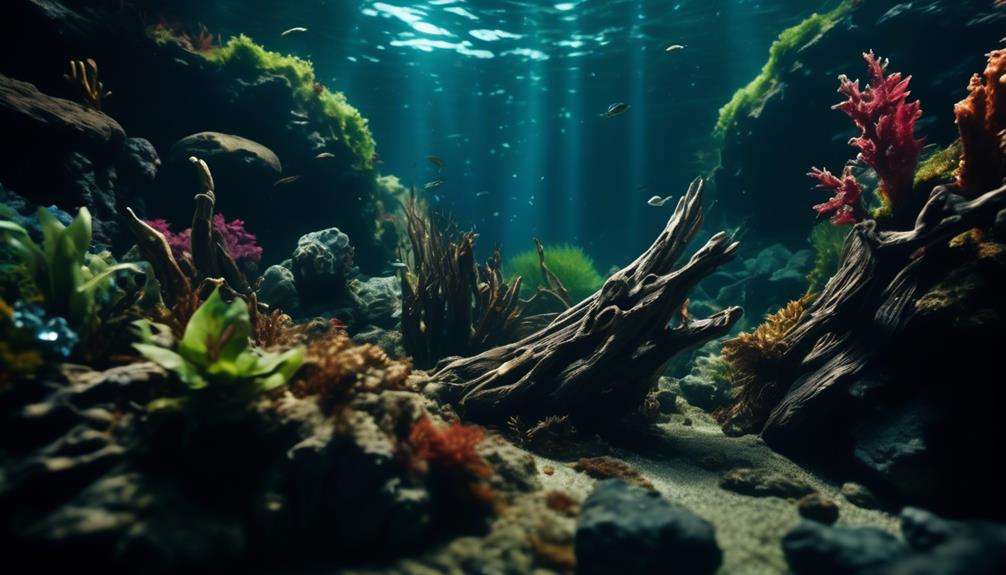
To address the destructive nature of Oscars and create a more harmonious aquarium environment, owners should carefully consider the selection of suitable tank decorations.
Here are three key factors to keep in mind:
- Durability: Oscars are known for their destructive behavior, so it’s important to choose tank decorations that can withstand their movements and rooting behavior. Opt for sturdy materials such as ceramic or resin that can withstand their aggressive nature.
- Non-toxicity: Oscars have a tendency to nip and bite at objects in their tank. To ensure their safety, it’s crucial to select decorations that are non-toxic and won’t harm the fish if ingested.
- Simplicity: Avoid tank decorations with intricate details or small parts that can easily break off. Oscars may accidentally damage or swallow these small pieces, leading to potential health issues. Keep the tank decorations simple yet visually appealing to create a safe and engaging environment for your Oscars.
Maintaining Live Plants With Oscars

Live plants can be a beautiful addition to an Oscars’ aquarium, but proper maintenance is essential to ensure their health and longevity. Oscars are known for their destructive behavior and have a tendency to uproot and destroy plants. Although they don’t usually eat live plants, their rooting behavior can damage plant roots. Therefore, it’s important to choose live plants that can withstand rooting and substrate disturbance.
Tank decorations should also be sturdy and resistant to Oscars’ movements. Regular monitoring of plant health is necessary, and damaged plant roots should be addressed promptly to prevent plant death. By providing the right conditions and taking necessary precautions, Oscars’ owners can enjoy the beauty of live plants in their aquarium while ensuring the well-being of their fish.
Tips for Keeping Oscars Happy and Healthy
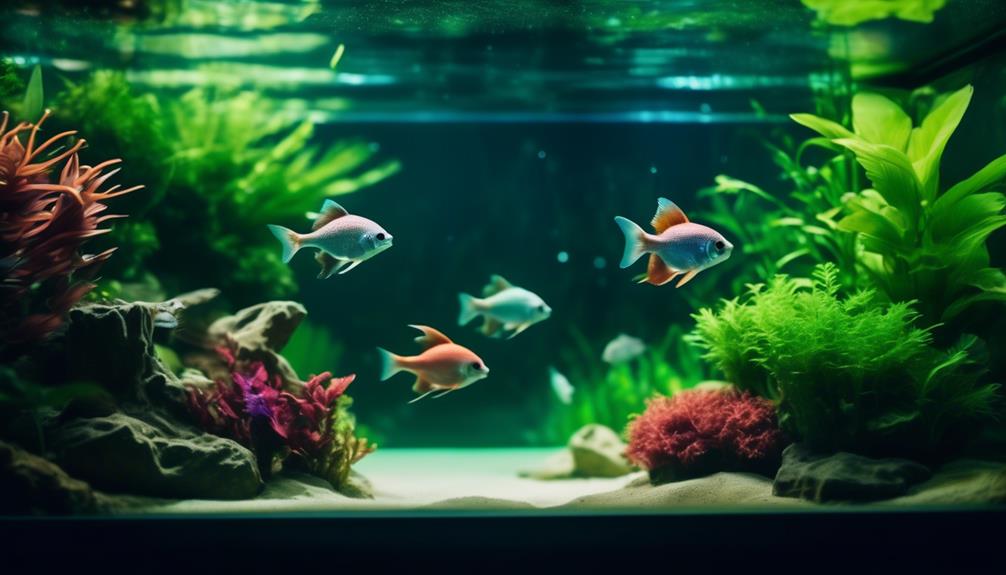
Keeping Oscars happy and healthy is essential for their well-being. To ensure their optimal health and happiness, here are three important tips to consider:
- Provide a spacious tank: Oscars require a large aquarium with a minimum size of 55 gallons for a single fish. This allows them enough space to swim and establish territories, reducing stress and aggression.
- Offer a varied diet: As carnivorous fish, Oscars need a diverse diet consisting of fish, worms, shellfish, shrimp, and occasionally beef heart. Including high-quality pellet foods can also provide essential nutrients. A balanced diet promotes good health and vibrant colors.
- Maintain excellent water quality: Oscars produce a significant amount of waste, so a strong filtration system is necessary to keep the water clean. Regular water changes and monitoring of water parameters, such as ammonia, nitrite, and nitrate levels, are crucial for their well-being.
Frequently Asked Questions
How Long Can Oscars Grow?
Oscars can grow up to 18 inches long. They are known for their beauty and have individual personalities. These aggressive and territorial cichlids require large aquariums and should be housed with other large, moderately aggressive species.
What Is the Origin of Oscars?
Oscars originate in the Amazon River basin in South America. They are a freshwater fish species and require large aquariums. Oscars are known to be aggressive and territorial, so they are best housed with compatible fish.
Can Oscars Eat Live Plants?
Yes, Oscars can eat live plants, but they typically do not. However, they can damage plant roots through their rooting behavior, so it’s important to choose sturdy plants that can withstand their actions.
What Type of Fish Can Oscars Be Housed With?
Oscars can be housed with large, moderately aggressive South American cichlids or catfish. It is important to choose tank mates that can tolerate their territorial and aggressive nature.
What Is the Typical Diet of Oscars?
The typical diet of Oscars consists of fish, worms, shellfish, shrimp, and occasional beef heart. They are also able to accept most meat-based pellet foods.
Are Gobies as Destructive and Aggressive as Oscars?
Colorful freshwater gobies thrive in aquatic environments and are known for their vibrant appearance. While they are not as aggressive and destructive as Oscars, gobies can still display territorial behavior. Proper tank setup and maintenance can help mitigate any potential aggression and ensure a harmonious coexistence with other fish species.
Conclusion
In conclusion, Oscars are fascinating and captivating fish with their destructive nature and aggressive behavior.
Understanding their physical characteristics, natural habitat, and tank requirements is crucial for their optimal care.
By providing suitable tank decorations, maintaining live plants, and following feeding patterns, fish enthusiasts can keep Oscars happy and healthy.
With proper care and attention, these stunning creatures can thrive in captivity and bring beauty and excitement to any aquarium.




